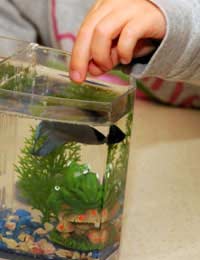Types of Fish Food

The classic imagery that comes to mind when feeding the fish is mentioned is dropping a spoonful of coloured fish flakes into a tank and walking away. Sounds easy right? While fish are definitely a low maintenance pet, there’s more complexity to the art of feeding the fish than just dropping a few flakes in the water. And fish keepers can definitely liven things up with a wide array of foods for their fish, if they so wish.
When to Feed
Fish fare better on several small feedings throughout the day, rather than one large dose of fish food. Smaller feedings also help to keep the water less cloudy and polluted as excess food floating around in the water clogs up the filters, air pumps and increases the amount of algae that grows in the tank. A good rule of thumb for feeding fish is to give only as much food as your fish can consume in under 5 minutes, no more. Herbivore fish in particular benefit from several feedings throughout the day rather than one large feeding. The exceptions to this rule are the bottom feeders. It’s best if bottom feeders are fed at night, after the quicker moving top dwelling fish have already gotten their food. This way your bottom feeders don’t need to compete for something to eat and you’ll know they’ve been fed. Just before you turn off your lights, drop the food for bottom feeders into the tank.What Type of Food Does My Fish Need?
Fish food falls into 5 basic categories:- Processed food like flakes, pellets, biscuits and sticks
- Live foods
- Freeze dried foods
- Frozen foods
- Fresh foods
The other 4 food groups are great ways to put a little excitement into the fish diet and also give you as the fish keeper an interesting break from the monotony of feeding fish flakes and other processed foods. In particular, live foods such as bloodworms, fruit flies and water fleas can really work fish into a frenzy as these foods provide some wriggling action that combines nutritional value with entertainment factor for your fish. Be aware that there is some risk of disease present in live foods, though. Freeze dried and frozen foods are safer ways to feed these same foods, but they must be defrosted or saturated with water and don’t provide the same sense of action to you or your fish, of course. Herbivores really benefit from some fresh foods like vegetables in their diet to supplement the vegetable tablets they are fed. Broccoli flowers, courgette, cucumber, peas, blanched leaf greens, algae and seaweeds can add some zest to their diets.
Storing Fish Food
In order to keep fish food fresh, store food in an airtight container in a cool, dark place. Vitamins and minerals in fish food start to break down when light hits them, if the container is left open or the food gets damp, so it’s best to keep a little in a small container and the rest in freezer. The lower the temperature, the longer it takes for nutrients to break down. Try not to leave fish food on top of the tank as this is both damp and warm, terrible for food breakdown. Check the dates on fish food before buying, processed food should only be kept for a month or so and frozen food should never be kept longer than 3 months in the freezer.If there is food left in the water after a feeding, use a net to get it out rather than leaving it to rot and pollute the tank. It’s also a good idea to lift up large decorations and rocks once a week to make sure no food is decomposing underneath.
For more information about keeping fish as pets, why not visit www.tropicalfishexpert.co.uk.


Re: Is Your Child Ready to Walk the Dog?
I am a 12 year old that love dog and I love walking your dog so pls let me do so
Re: Is Your Child Ready to Walk the Dog?
Hi I am eva I am 11 and my freind is 10 me and my freind love dogs and love walking and have loads of experience with…
Re: Is Your Child Ready to Walk the Dog?
My name is halima and I am 10 I want to walk dogs because they are my favourite animal and I would enjoy to walk them
Re: Is Your Child Ready to Walk the Dog?
Hi,my name is Emma I am 13 years old I have 2 dogs of my own and I train one of them I love all dogs and have walked…
Re: Is Your Child Ready to Walk the Dog?
Hi I'm Hamish I'm 10 years old I want to do dog walking to save up to spend time with my family in Australia I like dogs…
Re: Is Your Child Ready to Walk the Dog?
Hi,my name is Mario and I am looking for a job to do with dog walking,I’m looking to save up money for the summer
Re: Is Your Child Ready to Walk the Dog?
Hi,my name is Mario,I’m 11 years old and I’m looking for a job to do with dog walking,I need the job because I want to…
Re: Is Your Child Ready to Walk the Dog?
Hi my nam is Harley I want to walk dogs with my friend Chris we are both 10 an experienced dog walking
Re: Is Your Child Ready to Walk the Dog?
Hello, I am 11 years old and I would love to be a Dog Walker! I have walked dogs all my life and been around animals all…
Re: Is Your Child Ready to Walk the Dog?
I love dogs but have to cats i want to walk dogs at age 13 now for a business and prices 5$ for 15 min 10$ for 30 15$…